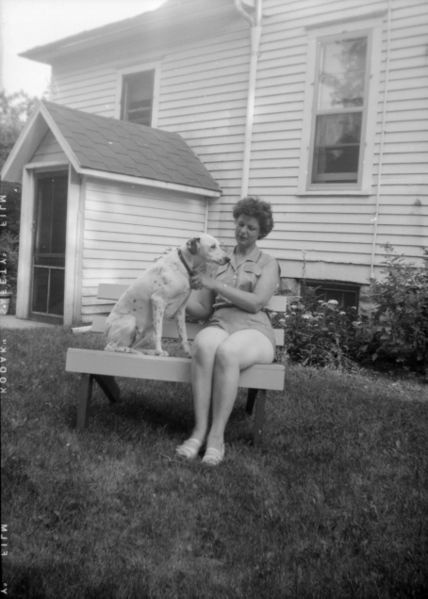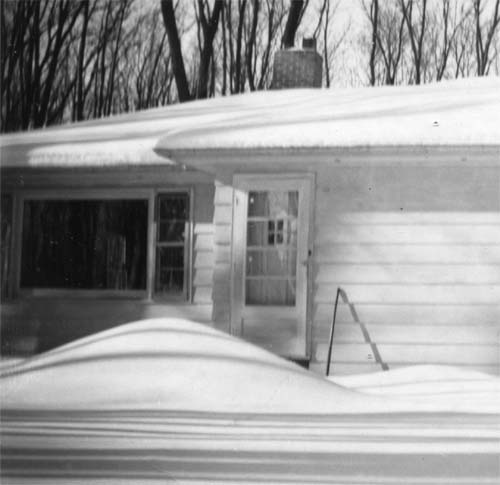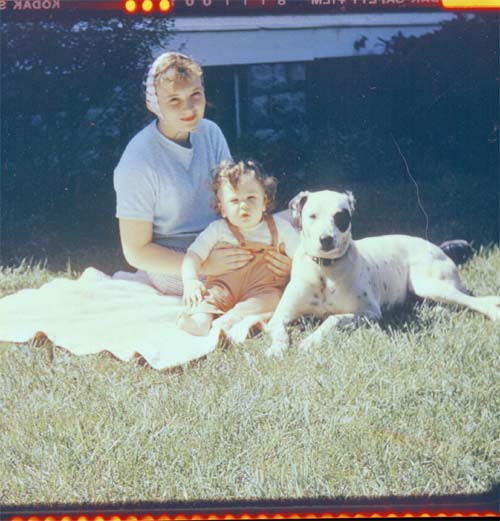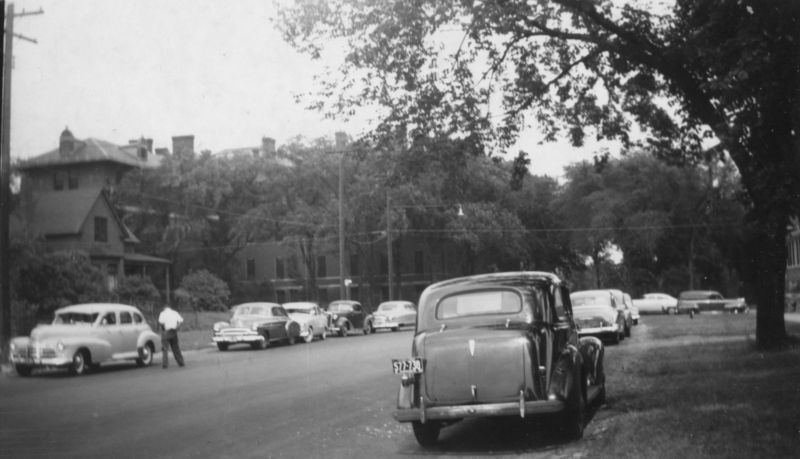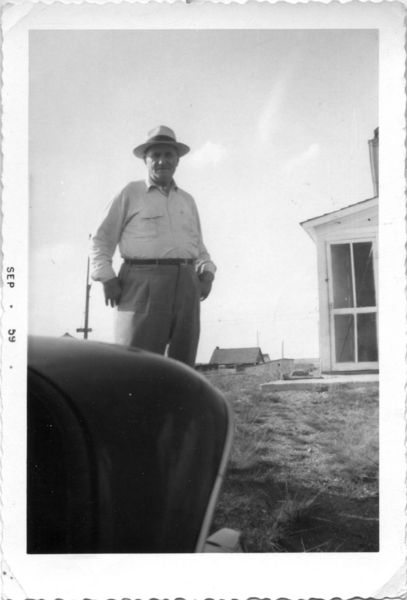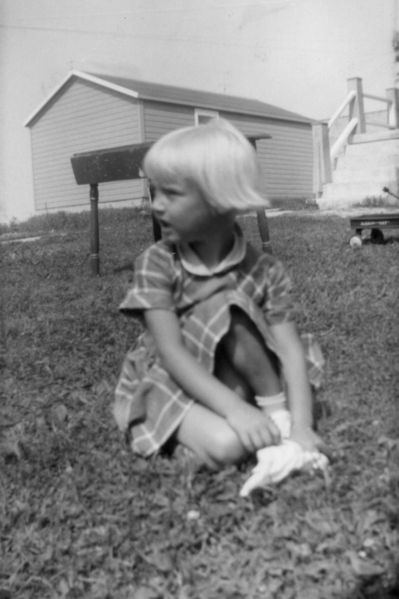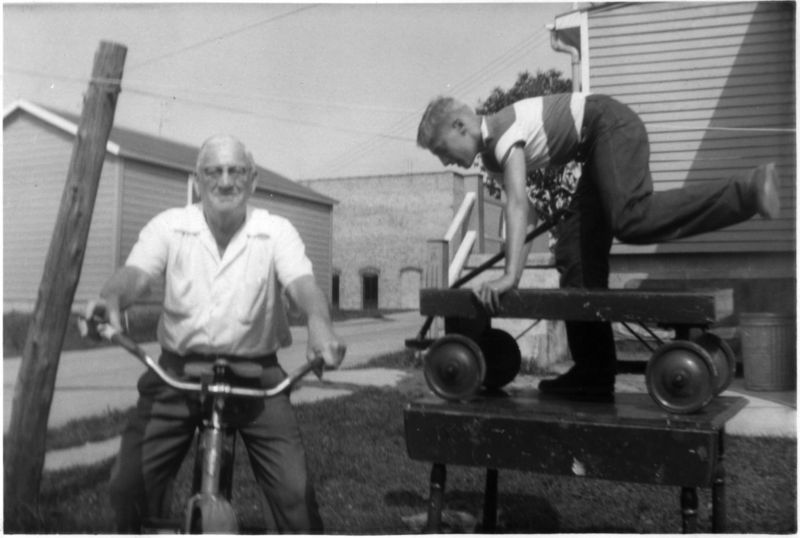Flooded Doghouse, 1950.
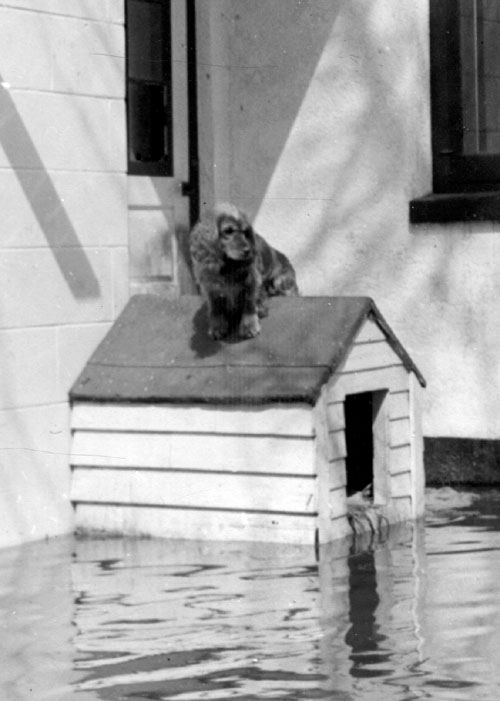
The 2009 Flood has crested in Grand Forks and the river is falling, but in 1950 even the dogs were victims. In this posed photo, an unhappy cocker spaniel surveys the swollen Red River of the North from the peak of his home, just outside a flooded Grand Forks house (the address, 317 Euclid Ave, no longer exists). From this group of photos.
Labels: 1950, 1950s, flood, grand forks, red river
Red River Flood, 1952.
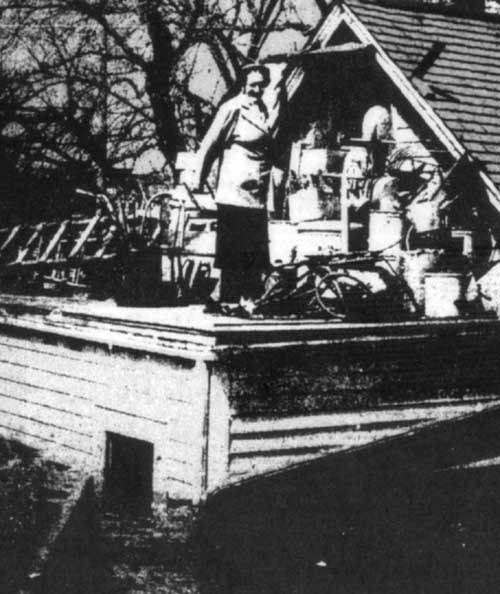
Click for full image
Mrs. Colin Campbell would not be ousted from her home: she is standing on the roof of her back porch, after climbing out a second story window. The water is about 4 feet away from covering her feet, but she was non-plussed; in the accompanying article, she defied police attempts to evacuate her, declaring it was a good time to catch up on her embroidery. On April 16, 1952, the Red River crested at around 35 feet; a USGS paper declared it the highest crest since 1897. Her address, 106 1st Avenue South, no longer exists; Urban Renewal wisely razed the neighborhood south of Main and east of 4th street, which was regularly subject to inundation even in light flood years.
Hollywood Highway, 1950s.
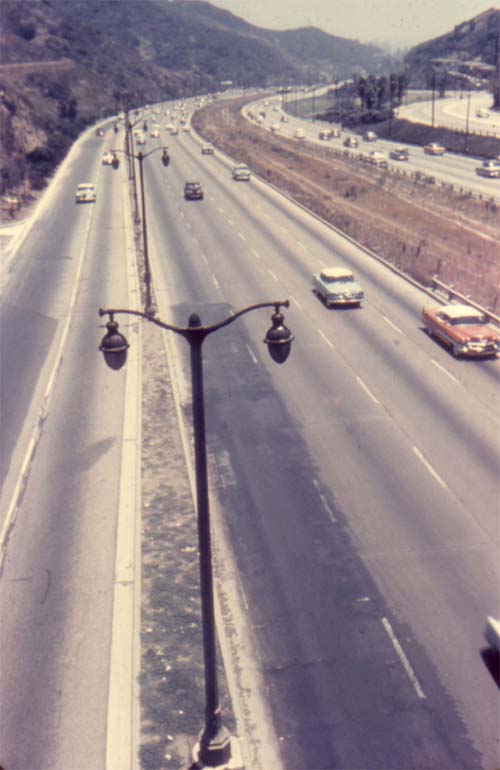
Click for full image
The Hollywood Highway, from a collectible set of slides honoring the Los Angeles Freeway System, vintage 1950s or 1960s.
Labels: 1950s, california history, freeway, highway, hollywood
Untitled Halsman, 1947.
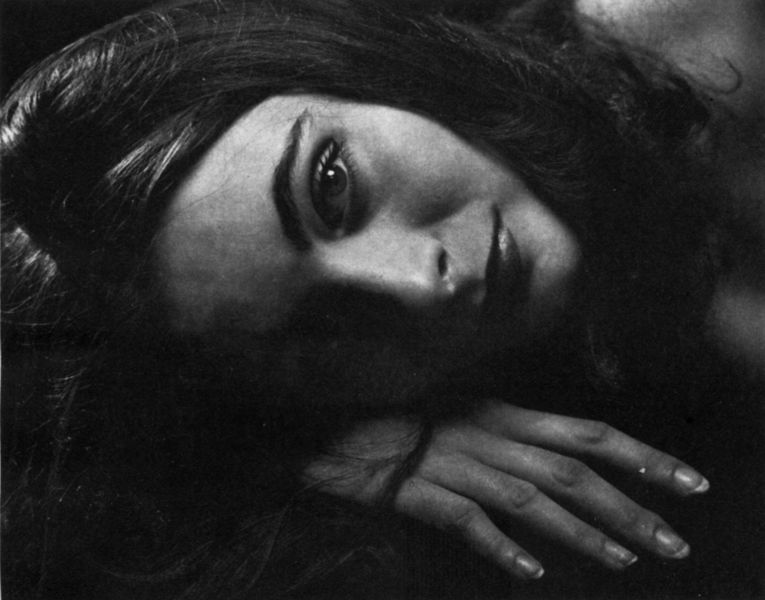
This photo appeared in The Photographer's Workshop in 1951, but the caption explains it was taken 4 years earlier when the young lady, a professional ballerina, was just 17 years old. The model is "Ricky" Soma, better known as Enrica Soma. In the gap between when the photo was taken and when it appeared in this magazine, the young ballerina had graced the cover of Life (also by Halsman, and probably taken the same time as the one above), married and separated from filmmaker John Houston, and, around the time this magazine was hitting newsstands, Soma was giving birth to actress Angelica Houston. Photo by Philippe Halsman.
Labels: 1940s, 1947, 1950s, 1951, ballet, enrica soma, Philippe Halsman
Malferd & Wife, 1953
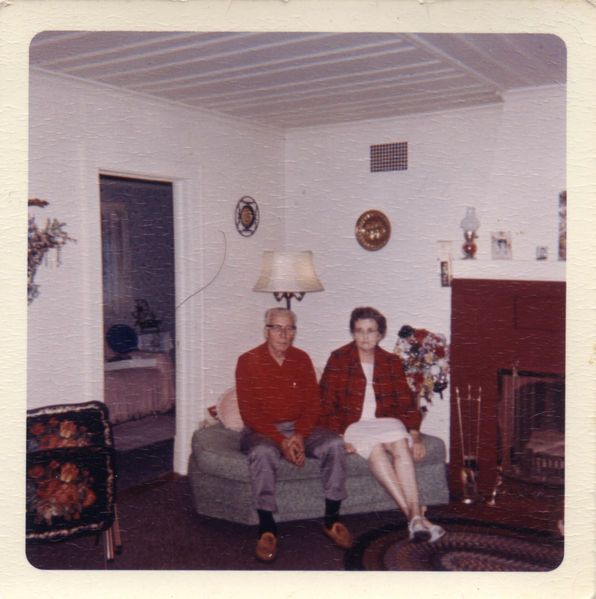
Malferd and his wife. Dated by lab, Dec 1953.
Labels: 1950s, 1953, interiors, minneapolis, older couple
Family Photo, 1950s.
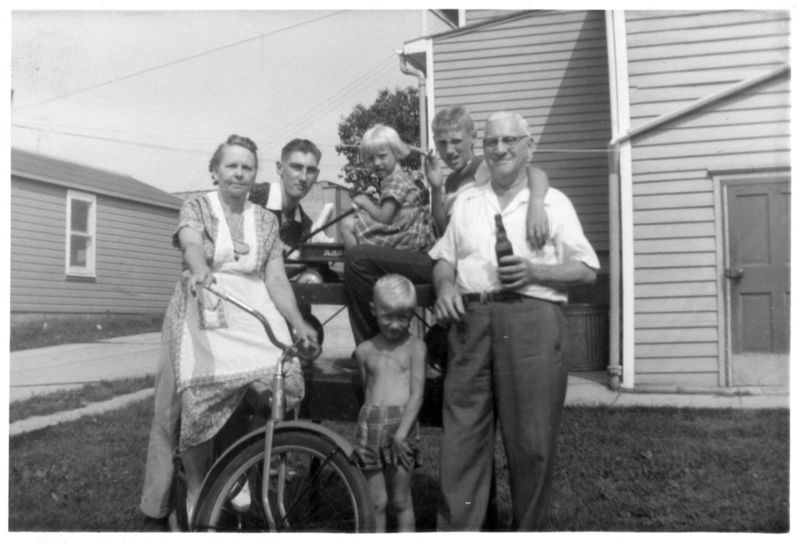
Family photo, 1950s. This photo appears to have been taken within minutes of this photo. The bicycle is a early-1940s Western Flyer, so it is possible the photo is older than I had originally thought. The girl in the background is sitting in a Radio Flyer wagon, set inside a wooden wagon, all stacked on a table.
Labels: 1950s, family photos, wisconsin history
Johnson-Restado Farm, 1955
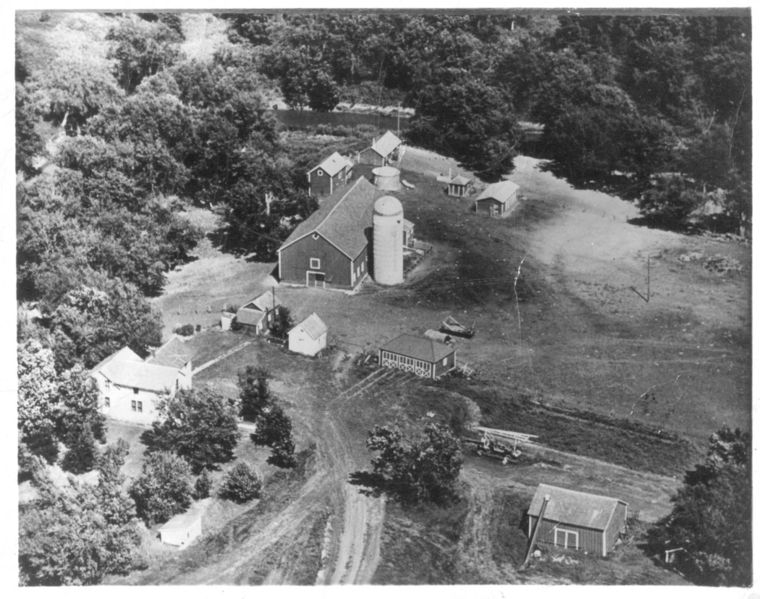
Labels: 1950s, 1955, aerial photo, farm
Suits, Ties, and Miller High-Life, 1957
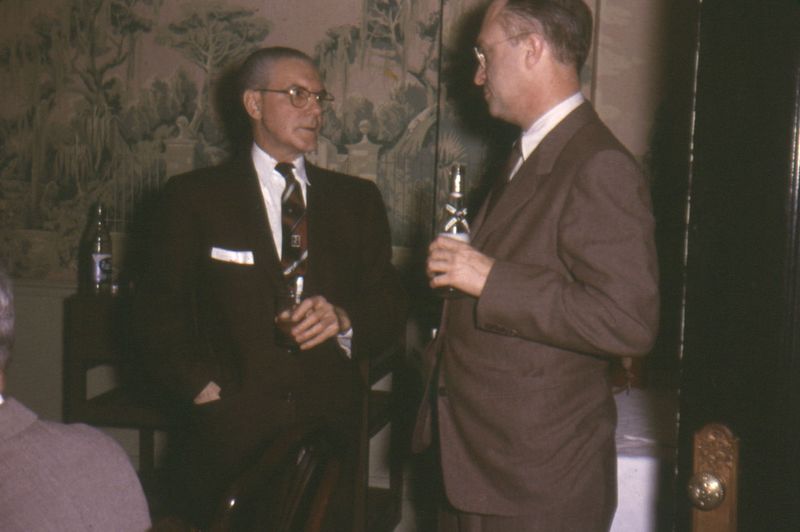
Taken at the Pfister Hotel, Milwaukee WI, February 1957. Color 35mm slide.
Labels: 1950s, 1957, miller high life, pfister hotel
Sue Ann, 1955
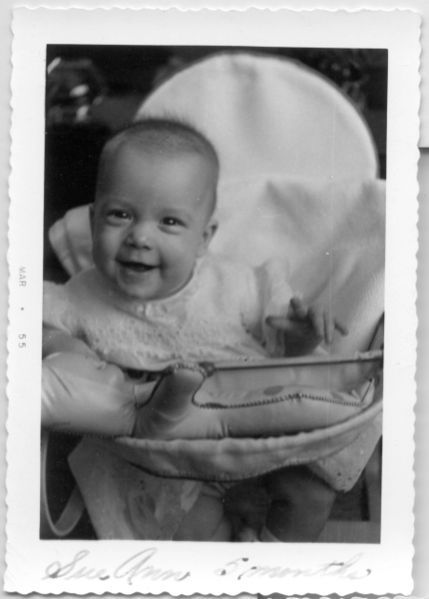
Captioned "Sue Ann 5 months" on the front, "For Grandma" on the back.
Labels: 1950s, baby, early 20th century farm photos
Getting a Trim, Whiskey In Hand
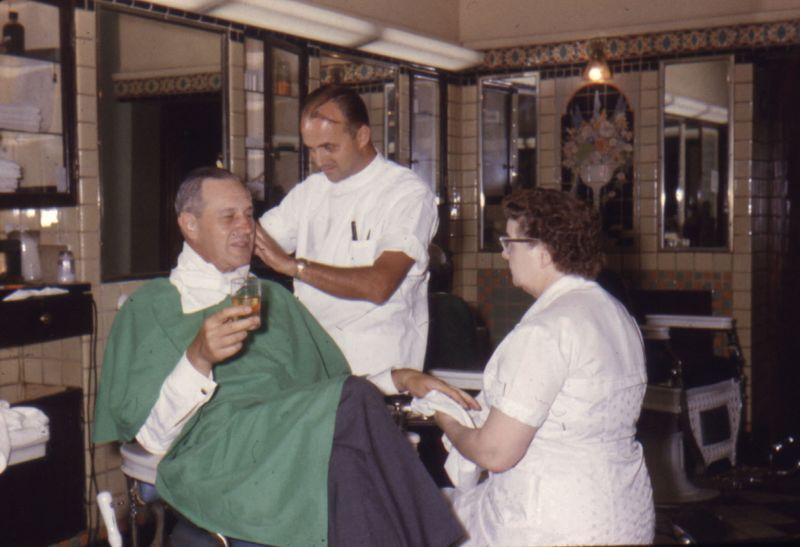
The barber shop in the Pfister Hotel, Milwaukee, WI. Noted, "Edmond, Alma", "7/59". Scanned from a 35mm slide (more Pfister)
Labels: 1950s, barber shop, pfister hotel
Cape Cod Illustrated
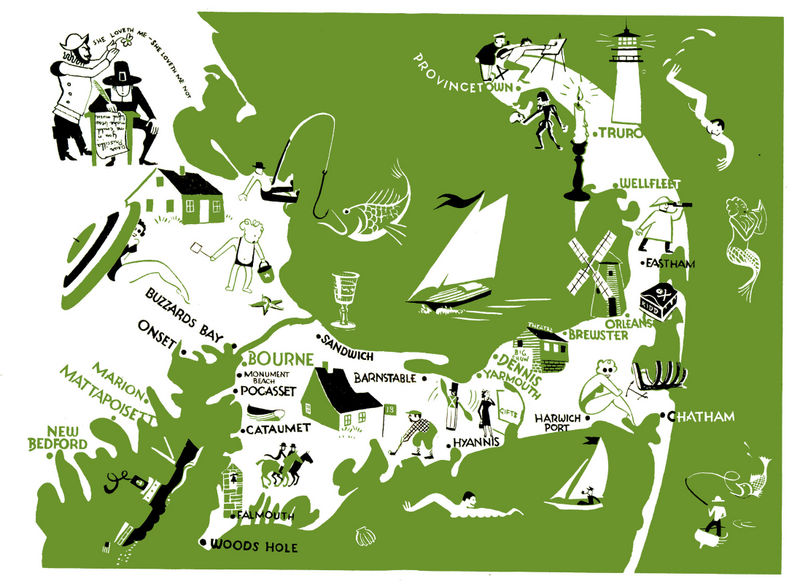
This map, short on words but large on illustrations, diagrams just a small portion of Massachusetts known as Cape Cod. It was printed as part of a booklet by the New York, New Haven, and Hartford Railroad Co (which, in turn, was part of a 7-booklet set covering the entirety of the railroad's reach). The booklets were designed for tourists and encouraged them to contact the railroads internal 'travel bureau', as though East Coast residents had no idea the Cape was known for its beaches and fishing -- although its target was probably not locals, but folks like me from the flyover states who'd be intrigued by the treasure chest marked "Kidd". I had no idea his lost treasure was marked so clearly on local maps!
The Stereo Realist In Wisconsin
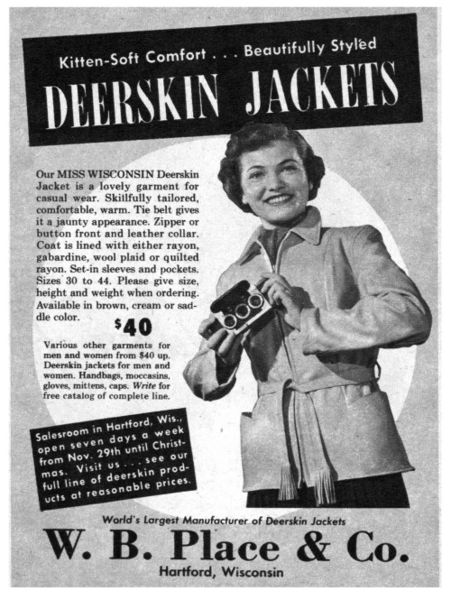 Today's image isn't about deerskin jackets, or who this model is, or about where in Wisconsin this advertisment comes from. In this lady's hands comes one of the technological marvels of the twentieth century: the Stereo Realist, a 3D camera that the average person could own and use.
Today's image isn't about deerskin jackets, or who this model is, or about where in Wisconsin this advertisment comes from. In this lady's hands comes one of the technological marvels of the twentieth century: the Stereo Realist, a 3D camera that the average person could own and use.First manufactured in Milwaukee, Wisconsin in 1947, the camera was produced for nearly thirty years and enjoyed a lot of publicity and popularity for a time. The camera used regular 35mm film, still the standard size today, which also made processing more available to the public.
The advertisment comes from the Milwaukee Journal's Sunday Picture Journal, December 7, 1958, putting it well within the era of the Stereo Realist's popularity. The Stereo Realist had a very high-profile life, though, as a photographic toy carried by celebrities of all kinds, from Vincent Price to Dwight Eisenhower. What better way to add to the class and style of a deerskin jacket than to include a home-town boy that went and got famous? The camera had a reputation for being mechanically complex, but the designer accomodated this with quality structure, and the camera's downfall wasn't complexity or difficulty but an overall decline in 3d photography. Still, just put "stereo realist" into a search engine, and you'll find rabid collectors who want the camera in the ad -- that specific camera -- in their collection.
Labels: 1950s, 1958, 3d photography, stereo realist
The USS Nautilus. Artist's Impression
 In December, 1952, Collier's Magazine made the USS Nautilus its cover story. Nautilus was the first US nuclear-powered sub, and it set record after record during its time at sea. The date of the Collier's article, however, is a clue to this picture's origin. Construction on the Nautilus started 14 June 1952, and the ship wasn't seaworthy until 1954. The design for the sub was definitely in existence, but the ship itself was still a few years away. With the help of Rear Admiral Homer N Wallin, Collier's was able to assemble an excellent description of our newest not-so-secret weapon.
In December, 1952, Collier's Magazine made the USS Nautilus its cover story. Nautilus was the first US nuclear-powered sub, and it set record after record during its time at sea. The date of the Collier's article, however, is a clue to this picture's origin. Construction on the Nautilus started 14 June 1952, and the ship wasn't seaworthy until 1954. The design for the sub was definitely in existence, but the ship itself was still a few years away. With the help of Rear Admiral Homer N Wallin, Collier's was able to assemble an excellent description of our newest not-so-secret weapon.The above image has to be enlarged to be appreciated; the detail is tremendous, and I'd bet the original was huge. The diagram spanned two pages, from edge to edge. I find it a bit disconcerting that the area marked "nuclear lab" is right next to the galley, but I'd imagine that this artist's rendition isn't completely accurate; it does closely resemble the map seen here, though. The article gives quite a few details about the Nautilus' capabilities, no doubt as a show of US power and induce fear in our enemies of the surprise attack from such a formidable opponent. The details in the diagram above do show a bit more than I'd expected -- in the room marked "Crew's Quarters", the following detail is shown:
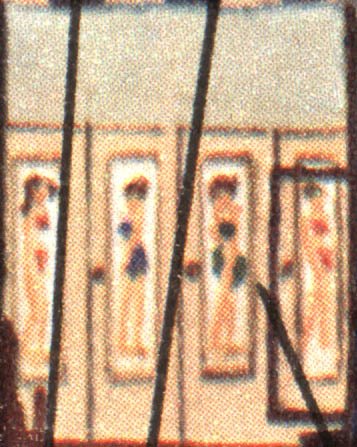
Yes sir, our red-blooded sailors, spending months cruising beneath the choppy waves, will enjoy the companionship of the all-American pin-up gal (nsfw). Maybe the artist was far more truthful about the submarine's nature than I thought.
Labels: 1950s, 1952, cold war, collier's magazine, nuclear submarine, uss nautilus
Travelling By Corvair
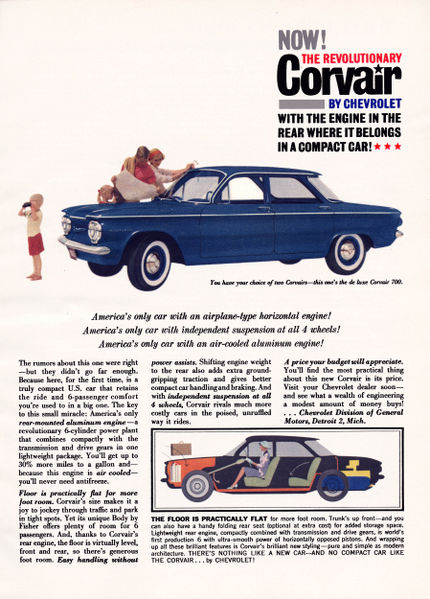 America's only car with an airplane-type horizontal engine!
America's only car with an airplane-type horizontal engine!America's only car with an independent suspension at all 4 wheels!
America's only car with an air-cooled aluminum engine!
This ad for Chevrolet's Corvair from 1959 shows just how advanced the little car was -- largely inspired by the Volkswagen, the Corvair put an ample air-cooled engine inside a compact body (although a bit larger than a VW), and championed it as the low-cost car of the future. Compare to the Corvair's contemporaries of the late 1950s: big steel behemoths with cast-iron monstrous engines up front where they belong. The Corvair's competition was almost entirely European imports like the VW, Volvo, and Porche, so Chevrolet was carving a new market for their vehicles, feeding American steel to the customers in need of a good 'ol American machine, and something small and efficient for people looking for something more manageable.
The Corvair, as Mr. Nader will gladly tell you, was a victim of its advanced design -- that fancy suspension in the ad was prone to causing catastrophic accidents, and the rear-weighty engine location caused steering issues for drivers. Deaths, sadly, result in distrust for the new technology, and despite a much-too-late redesign with the '64 models by '69 the car was done. Rear-engines in American cars never really went far; the Corvair was one of the last, although Pontiac (who had also tried a rear-engine with their Polaris prototype) went with a mid-engine in the Fiero, and Pontiac's ex-designer John DeLorean put a rear engine in his DMC 12.
Labels: 1950s, 1959, advertisement, automobilia, chevrolet, corvair
Perry Como's Wanted Poster
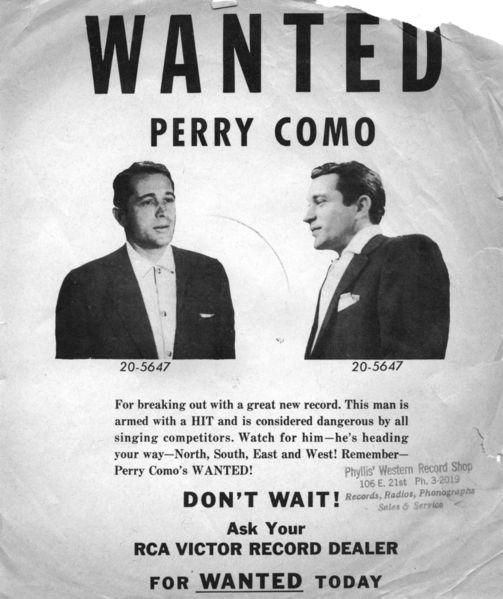
In 1954, Perry Como released "Wanted" on a 10-inch 78, with "Look Out Your Window" as the B-side; both went up in the charts quickly with Wanted hitting #1. Despite Como being in the prime of his career, RCA made sure the word got out and released this promotional flyer, perfect size for slipping in the 10" record sleeve of Como's other albums. Como is accused of the horrendous crime of 'breaking out with a great new record' -- something 'dangerous [to] all singing competitors'! Accusing the white-bread, good-natured Como of a crime was a playful turn, but a bit different from the song: Wanted's lyrics addresses a woman's criminal act of finding her way into another man's arms. It seems everyone was engaging in criminal activities! The final line of Como's crimes uses a apostrophe pun. It could mean, depending on whether the apostophe is a contraction or a possessive, either "Remember -- Perry Como is Wanted", or "Remember Wanted, by Perry Como." That number under Como's name? It looks like it could be the number off his jailhouse uniform...but it is, in fact, RCA's catalog number for the Wanted record.
As a sidenote, I tried to track down Phyllis and her Western Record Shop. Sadly, I have no way of knowing where she was located. I got this flyer exactly how it was intended -- stuffed in a 78 of one of Como's other early-fifties albums -- but it was purchased from a travelling Texan antique show dealer, so Phyllis could have been dealing in phonographs anywhere from here to Amarillo.
Labels: 1950s, 1954, advertisement, perry como, record album
Salvador Dali Bloopers
In the 1940s, Salvador Dali and Philippe Halsman teamed up and produced a number of surrealistic works of photographic art -- some are iconic, like In Voluptas Mors and Dali Atomicus, but the pair produced many different photos during their collaboration. Others, like this one (I was unable to find its title) and Midsummer Night's Mare, made it to film but did not achieve the acclaim that Mors and Atomicus did. It's easy to forget, when seeing the final results of such a mixing of the minds, that great art isn't a coincidence or a singular act -- producing art requires practice, numerous mistakes, and attention to detail that makes the final product look effortless. The Fall 1950 issue of Photography Workshop stripped away a veneer of that pseudo- effortlessness. In an extensive article about Halsman, they included four 'outtakes' from Atomicus, the unnamed photo above, and another unnamed photo I could find no other source for:
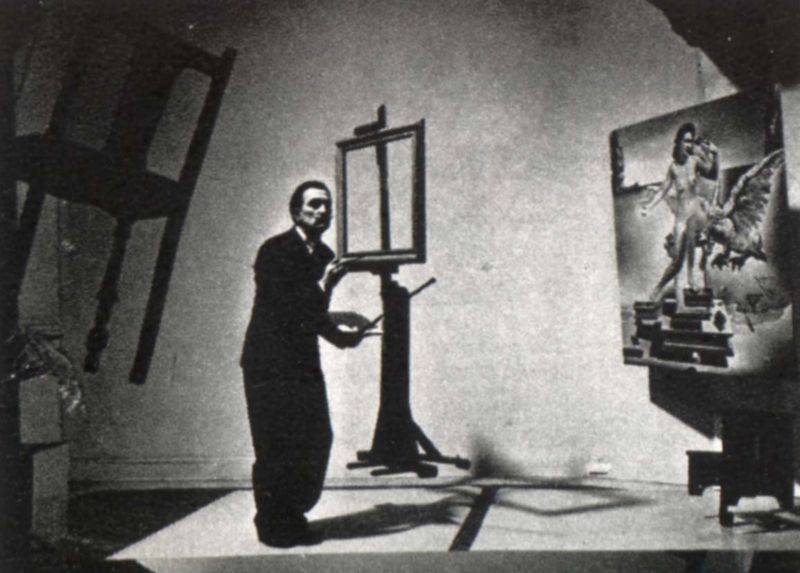
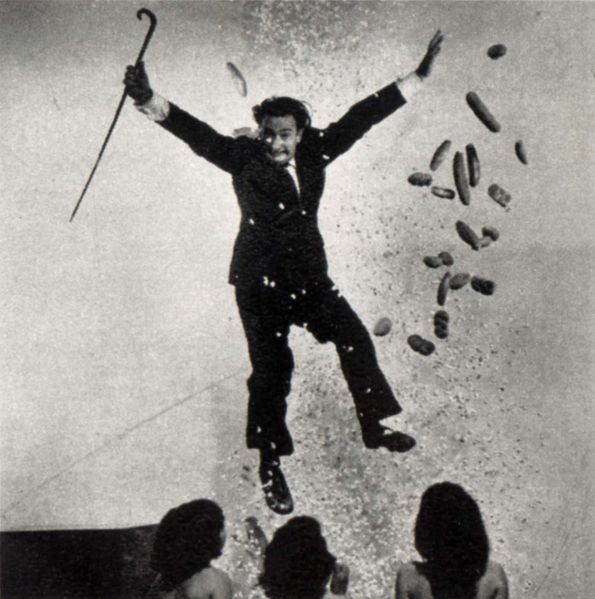
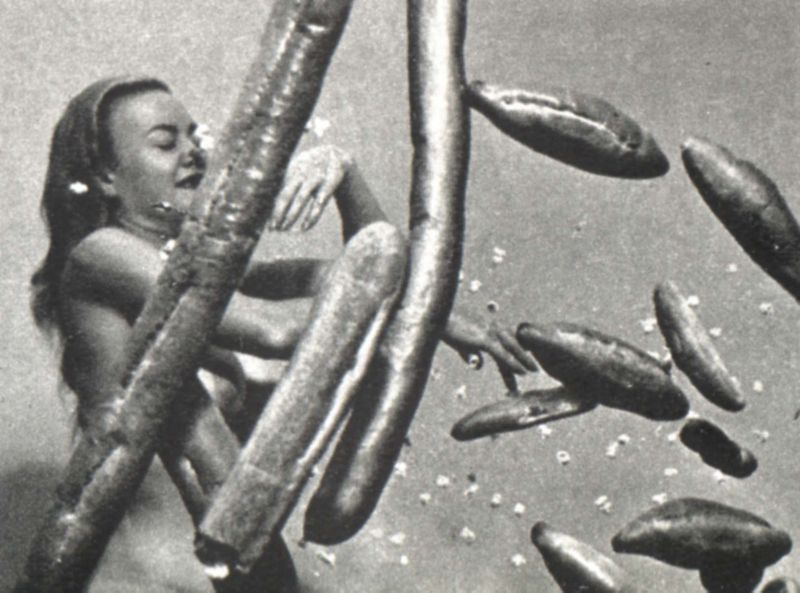
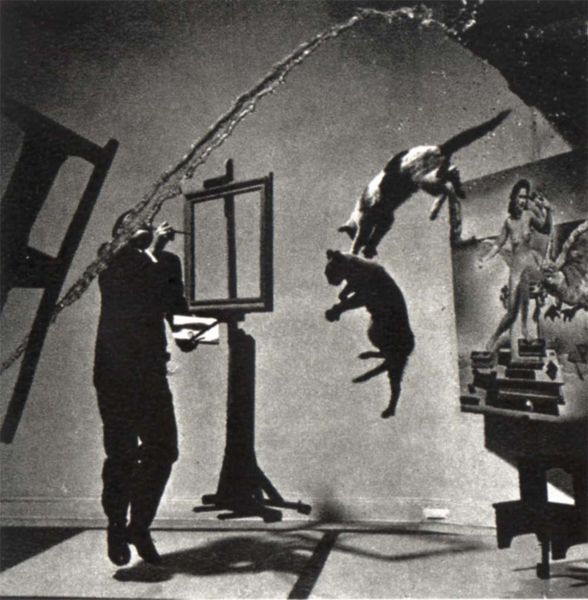
The Atomicus photo, the most famous of the Halsman/Dali colaborration, took 28 takes -- "after each exposure, while the assistants mopped the floor and reclaimed cats, Halsman developed the film to see the progress in the composition. Accidents would happen. The water, intended for the cats, would cover Dali's face instead."
Labels: 1940s, 1950s, creative process, Philippe Halsman, photography, salvador dali
San Francisco, via Gray Line
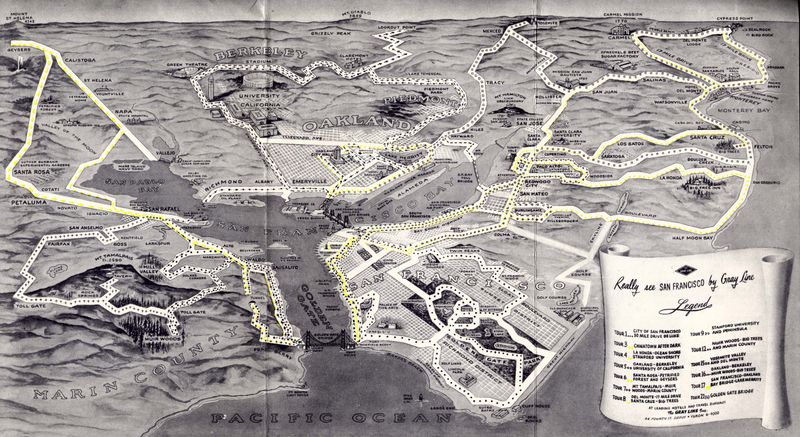
San Francisco still has Gray Line offering bus tours of their beautiful city, all these years later. The map above is from 1953, from a pamphlet called "Really See San Francisco." I'm just including the map here, but the rest may follow someday. Nearly 60 years ago, here's what the attractions via a bus tour were:
- Deluxe 30-mile drive around San Francisco
- Chinatown After Dark
- La-Honda, Ocean shore, and Stanford University
- Oakland, Berkeley, and U of Calif.
- Santa Rosa, Petrified forest and geysers
- Mt Tamalpais, Muir Woods, and Marin County
- Del Monte, Santa Cruz
- Stanford University and peninsula
- Muir Woods, big trees, and Marin County
- Yosemite Valley and Del Monte
- Oakland, Berkeley, Muir Woods, big trees
- San Francisco, Oakland, Bay Bridge, Lake Merritt
- Golden Gate Bridge
As for the map itself: I'm a fan of purposeful maps, ones that don't spare the information about what it feels relevant, but ignores the irrelevant whenever possible. This isometric view includes landmarks and gives a nice sensation of distance, which then also lets riders know how much time will be spent looking out the window at non-landmarks.
Labels: 1950s, 1953, california history, gray line, maps, san francisco
The Invisible Jet Fighter
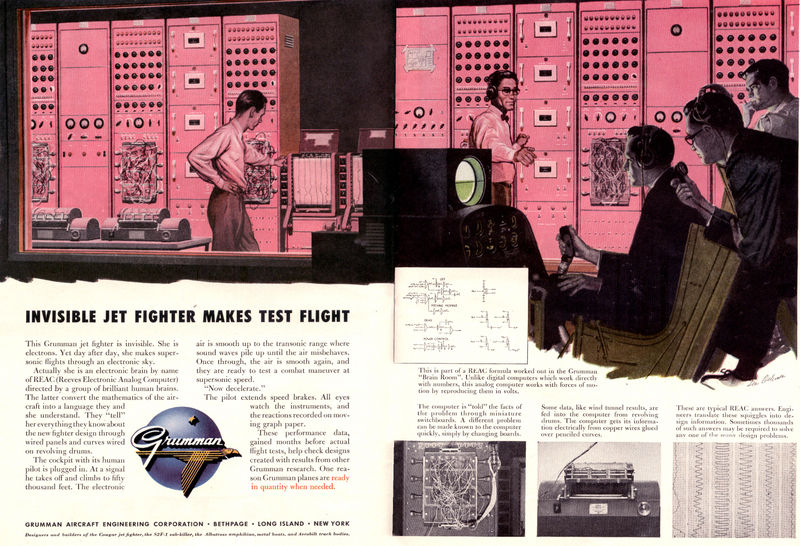
No, we're not talking about stealth fighters -- Grumman's invisible jet fighter was an example of a very early flight simulator. Using a Reeves analog computer, Grumman compiled test data using models and simulations to program the computer and 'flight-test' imaginary aircraft's data against actual flight information. Analog simulators had been around for about a decade, and digital simulators were gaining a foothold (although, as the advertisement says, Grumman didn't think much of digital simulation). Analog eventually gave way to real-time digital simulation with the Navy's UDOFT, the Universal Digital Operational Flight Trainer, which started shortly before Grumman's ad but wasn't completed until 1960. As you might guess, these projects eventually spawned imitators in the private sector, resulting in grainy, wireframe simulators -- that ran on small personal computers.
Labels: 1950s, 1954, analog, computers, flight simulator, grumman, history
In The Bath: November 1954
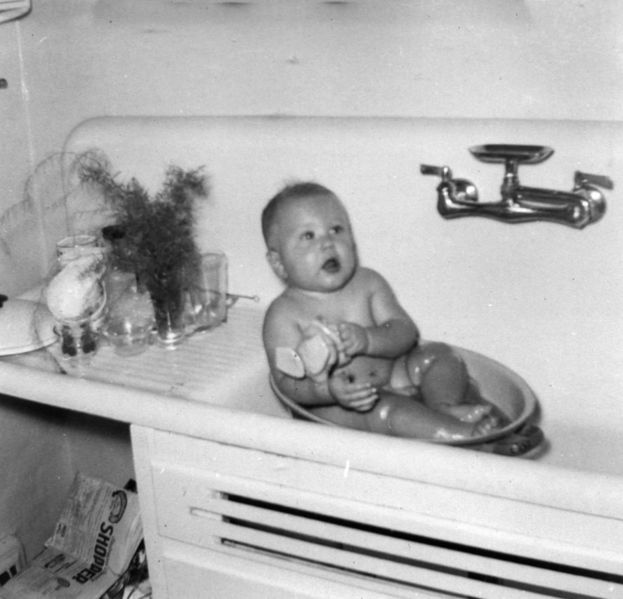
I know I've been heavy on the analysis lately, so in today's post I have nothing to say about the sink; I can't tell you about the toy the baby is playing with; I don't know where the newspaper is from, or what its articles are about; I have nothing to say about asparagus ferns being grown in drinking glasses nor the appropriate use of a roasting pan to bathe small humans. All I know is there's some 55-year-old man who probably doesn't want the whole world to see him naked....yet here he is.
Labels: 1950s, 1954, baby, bath, naked, roasting pan, steel sink
Socialized Power For Our Children
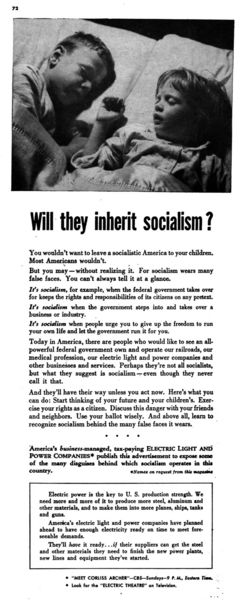 My first reaction was that this advertisement, published in a 1952 farming magazine, was steeped in anti-communist propaganda. After all, socialism and communism are terms arm-in-arm, almost interchangeable, depending on where they're used. The Union of Soviet Socialist Republics was the enemy, we had just defeated Germany's National Socialist party, so in 1952 socialism seemed to be America's greatest enemy.
My first reaction was that this advertisement, published in a 1952 farming magazine, was steeped in anti-communist propaganda. After all, socialism and communism are terms arm-in-arm, almost interchangeable, depending on where they're used. The Union of Soviet Socialist Republics was the enemy, we had just defeated Germany's National Socialist party, so in 1952 socialism seemed to be America's greatest enemy.The threat here turns out to be closer to home. Eisenhower, as I mentioned a couple days ago, was quite 'left' when it came to socialized and public works. Socialized power, or, rather, federally-funded power plants, was high on Eisenhower's 'to-do' list. Eisenhower didn't have some haughty Marxist ideals -- he had been a leader during WWII, and saw first-hand how a country's strong infrastructure kept it operating during adversity. Eisenhower's highway system is still the road upon which American commerce and communication rolls, and he thought having federally-controlled electricity would allow the country to weather problems by controlling the source. Private electricity companies, as you might gather, felt quite threatened by the possibility of their racket being leaned on by government influences. "Won't Someone Think of the Children?" the power companies cried, so soon forgetting how Roosevelt's REA program brought hot water and radio to the children of the farmers that bought this magazine. At least with REA, private companies got the money for the work -- turbines at Niagara was another thing altogether.
(click the image to read the content of the ad)
Labels: 1950s, 1952, eisenhower, propaganda, socialism
Harriman and the Naughty Strawberry Blonde
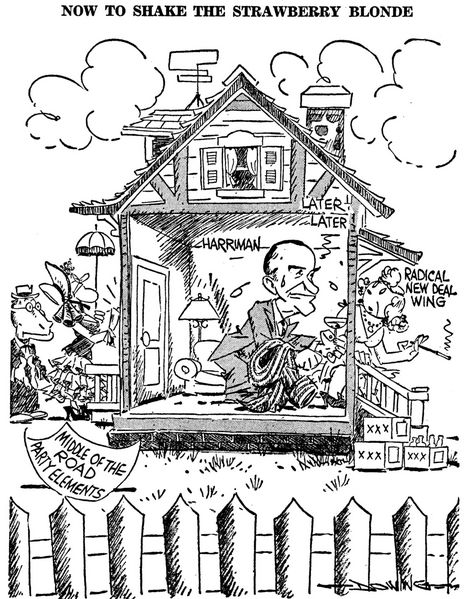
At the end of 1955, candidates were ramping up their target of the Presidency of the US. Adlai Stevenson ended up the Democrat candidate, losing the election, but the second place for the candidacy was Averell Harriman.
Harriman was a serious contender; he had been holding offices of one sort or another (the Governor of New York at the time), and a few short weeks after the political cartoon above Harriman appeared on the cover of Time magazine. Harriman was a New Dealer during Roosevelt's days, but his rich family gave him appeal to businesses and the Wall Street crowd. Eisenhower had continued many New Deal programs on his own, so why the comic?
Let's take it apart: Harriman, a New Deal proponent, was a early Democrat contender. However, he's got the money and big business interests in his pockets. Eisenhower, too, kept up with the New Deal and worked towards balancing the budget, while working on military strength. Harriman, it seems, was more like the Republican incumbent than the Democrats wanted -- the comic implies that the Democrats were looking for a more centrist candidate. Harriman was 'sleeping' with the leftism of the New Deal, hiding his vices out the back door -- but Harriman was about to greet the centrist Democrats with open arms while his vices patiently waited out back. Public opinion must have agreed -- the more centrist Adlai Stevenson was brought back to run against Eisenhower for a second time, after losing in '52. Harriman, despite his early lead, apparently couldn't shake the strawberry blonde on the back step.
Labels: 1950s, 1955, adlai stevenson, political satire, presidential election, w averell harriman
Neptune Rex Endorses TWA
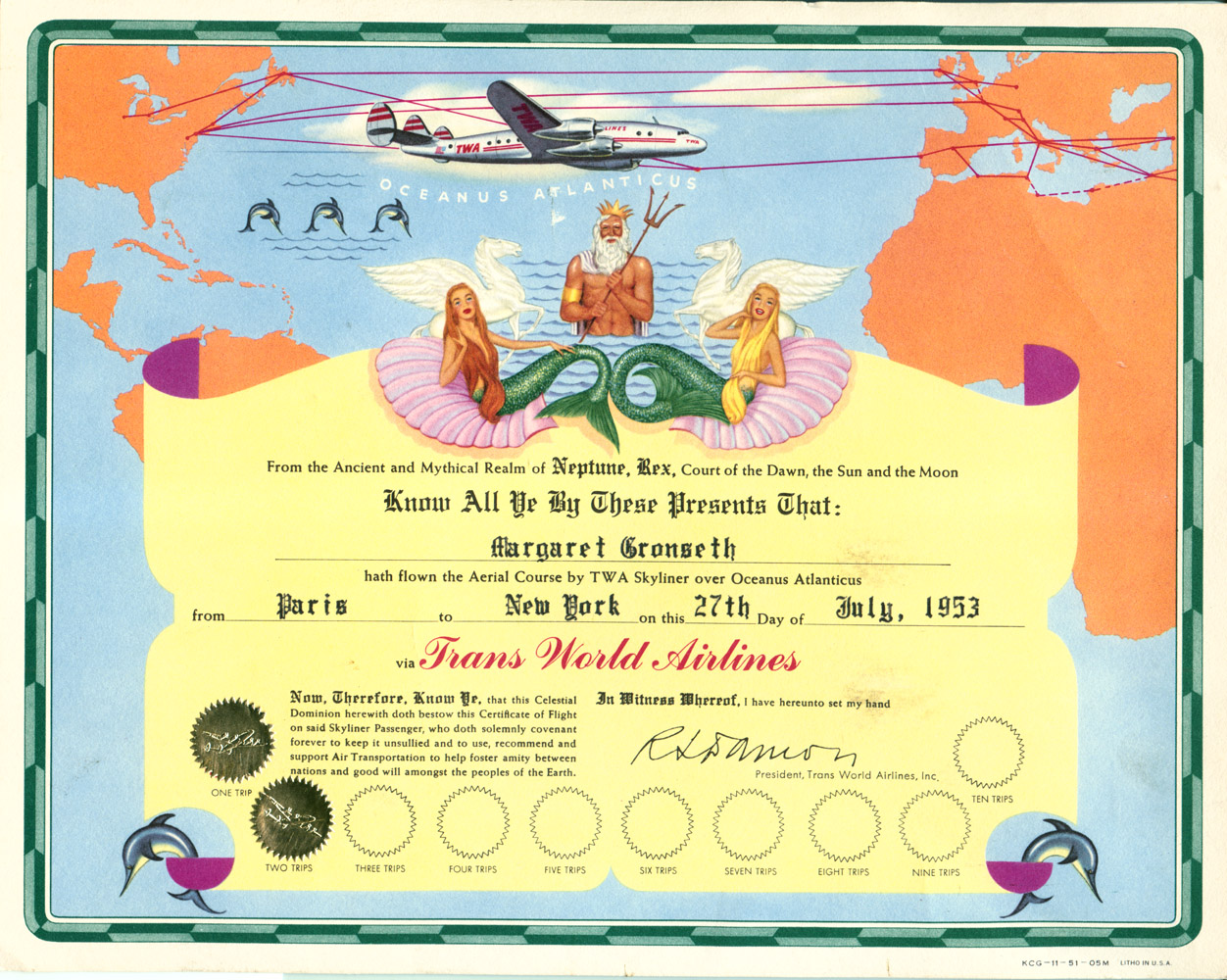 In July 1953, Margaret flew across the Atlantic ocean, from Paris to New York. This was during some of TWAs heydays -- Hughes was in control and hadn't gone completely nuts yet, of travelling abroad was still a luxury but was beginning to reach the common people during the postwar boom, and the process was more comfortable and safer than ever before. The bottom text is the most important to note, though: by being awarded this certificate, the bearer was bound to recognize that they were to promote air travel, and recognize its value to international relations. In the fifties, air travel wasn't just bus service between big cities -- it was diplomacy serviced by stewardesses.
In July 1953, Margaret flew across the Atlantic ocean, from Paris to New York. This was during some of TWAs heydays -- Hughes was in control and hadn't gone completely nuts yet, of travelling abroad was still a luxury but was beginning to reach the common people during the postwar boom, and the process was more comfortable and safer than ever before. The bottom text is the most important to note, though: by being awarded this certificate, the bearer was bound to recognize that they were to promote air travel, and recognize its value to international relations. In the fifties, air travel wasn't just bus service between big cities -- it was diplomacy serviced by stewardesses.see also: TWA history * Lockheed Constellation survivors * Fly TWA museum
Labels: 1950s, 1953, certificate, trans world airlines, transoceanic
The Hideout at the Comstock
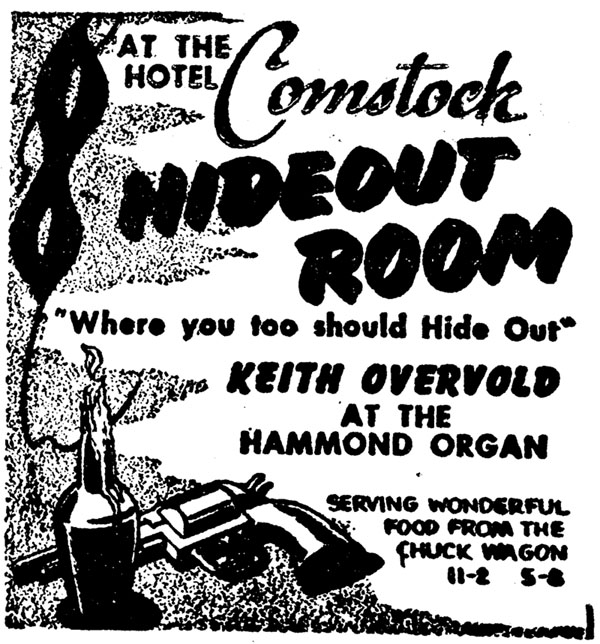
This came from a 1955 Moorhead Daily News, advertising the Comstock Hotel's Hideout Room. This appears to have been the hotel's lounge, featuring the dulcet tones of the Hammond organ. The Comstock was located in downtown Moorhead until Urban Renewal flattened and re-drew the flood-ravaged section of downtown to build a mall- wrapped- around- city- hall monolithic building that's struggled to keep shoppers and tenants. Personally, I prefer how the Comstock looked to the ultramodern styles of the buildings built in its place.
Labels: 1950s, 1955, advertisement, comstock hotel, minnesota history, moorhead
Buckskin Harry, Fargo TV Cowboy
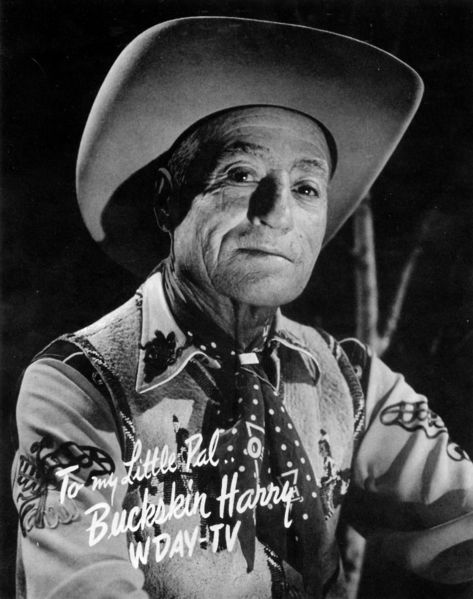 Buckskin Harry, as far as I can tell at this time, was a local television personality here in Fargo. Back in the day, local television stations did a lot more local programming than just the news; a lot of the national kids' shows like Bozo the Clown had its roots in local TV stations. Even into the 1980s local stations had thematic characters do intros and commercial bumpers for horror movies.
Buckskin Harry, as far as I can tell at this time, was a local television personality here in Fargo. Back in the day, local television stations did a lot more local programming than just the news; a lot of the national kids' shows like Bozo the Clown had its roots in local TV stations. Even into the 1980s local stations had thematic characters do intros and commercial bumpers for horror movies. We found this photo in a 1950s magazine, so it gave us a pretty good idea of about when 'ol Buckskin graced the boob-tube. Our first resource was my grandparents -- Grandpa Vernon remembered Harry on TV in the 1950s, but Grandpa was nurturing a new family around that time and wasn't watching mid-afternoon kids' programming.
Going through a 1955 Fargo Forum, I found some more specific information: Buckskin was on at 4 in the afternoon, an excellent timeslot lead into by Pinky Lee and Howdy Doody -- and Buckskin's show ran for an hour and fifteen minutes. I'm still doing my digging (my research method consists of doing very little, randomly encountering information...it works pretty well, actually), but if anybody out there remembers Buckskin, I'd appreciate any info.
Labels: 1950s, 1955, Buckskin Harry, fargophilia, WDAY
Smooching An Old Guy
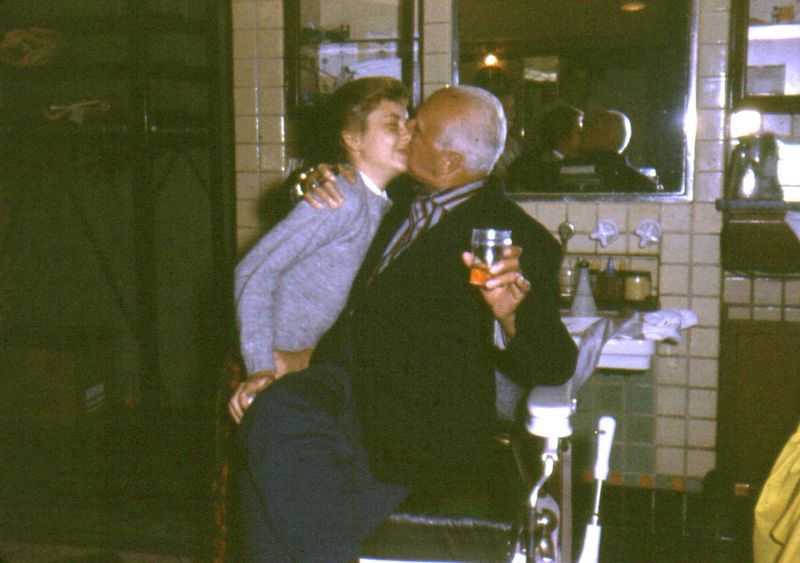 This photo was captioned "Jack, Obie Jordahl's Daughter, 8-24-57". Obie Jordahl, I believe, was a barber at the Pfister Hotel in Milwaukee, and this fine evening he brought his daughter along to a drinking session in the hotel barber shop. Thing got wild -- as you might expect -- and the young miss Jordahl met the fate seen above, photographed and stored for all time. Poor, poor girl.
This photo was captioned "Jack, Obie Jordahl's Daughter, 8-24-57". Obie Jordahl, I believe, was a barber at the Pfister Hotel in Milwaukee, and this fine evening he brought his daughter along to a drinking session in the hotel barber shop. Thing got wild -- as you might expect -- and the young miss Jordahl met the fate seen above, photographed and stored for all time. Poor, poor girl.Labels: 1950s, 1957, girl kissing older man, pfister hotel
Trompe l'Oeil At The Pfister
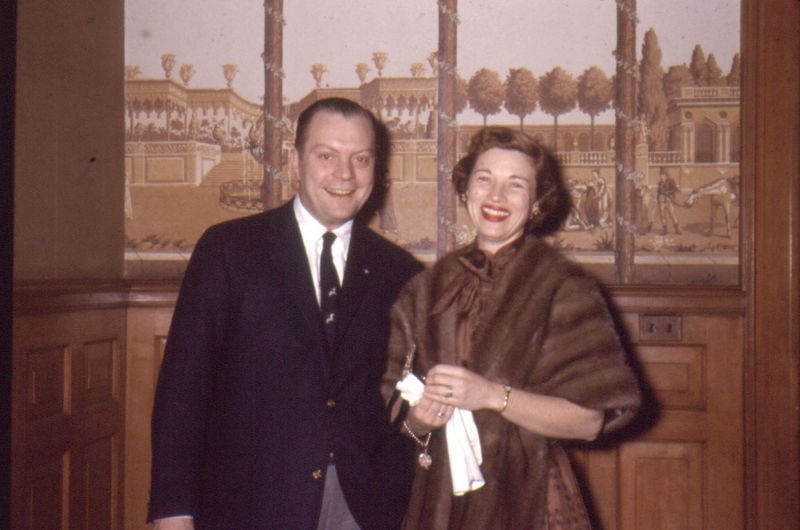 Say 'hi' to Larry & Ruth Smith, frequenters of the Pfister Hotel. This was taken in February 1957, along with several other photos I've uploaded. This photo has the best view of the trompe l'oeil wallpaper in the Pfister. A different wallpaper is visible in other photos, but this the best view of any of them. And it is wallpaper - you can see the seam just over the lady's right shoulder, and note how the wall in the distance doesn't line up between. The wallpaper artist used the ivy-wrapped columns to both hide the seam and create a 'break' to obscure varying views put side-by-side; my guess is that this paper (probably spendy) was sold with numerous vignettes, intended to be randomly juxtaposed for a more natural look. It was designed to be applied with a wainscoting, to leave the view appropriately at eye-level, and was probably quite expensive at the time. The Pfister was a classy place, though -- it was worth it.
Say 'hi' to Larry & Ruth Smith, frequenters of the Pfister Hotel. This was taken in February 1957, along with several other photos I've uploaded. This photo has the best view of the trompe l'oeil wallpaper in the Pfister. A different wallpaper is visible in other photos, but this the best view of any of them. And it is wallpaper - you can see the seam just over the lady's right shoulder, and note how the wall in the distance doesn't line up between. The wallpaper artist used the ivy-wrapped columns to both hide the seam and create a 'break' to obscure varying views put side-by-side; my guess is that this paper (probably spendy) was sold with numerous vignettes, intended to be randomly juxtaposed for a more natural look. It was designed to be applied with a wainscoting, to leave the view appropriately at eye-level, and was probably quite expensive at the time. The Pfister was a classy place, though -- it was worth it.Labels: 1950s, 1957, fur coat, pfister hotel, trompe l'oeil, vintage photo, wallpaper
Where Do The Animals Live?
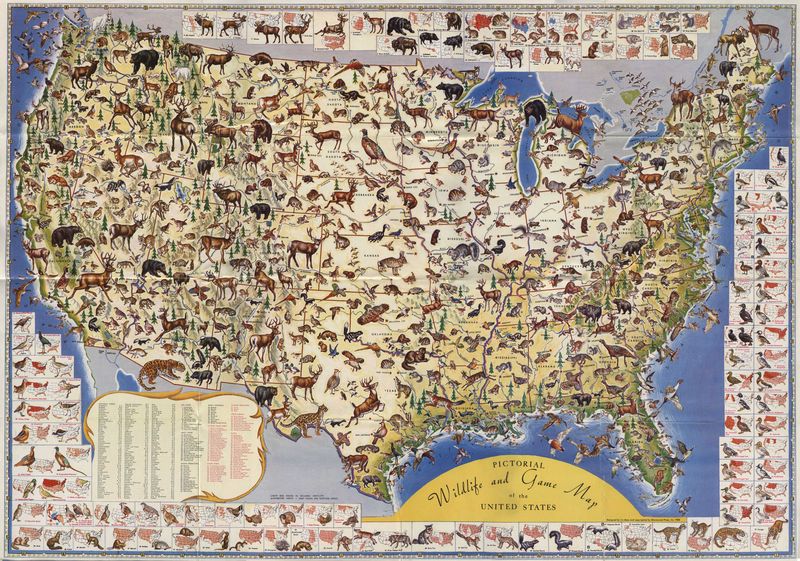 This is a "Pictorial Wildlife and Game Map" from 1956. Unlike a population map or 'Game of the States", this documents those critters we hate to have around, but really don't want to disappear. In terms of information use, the map is very cluttered, but it does an pretty job of covering migration ranges and general locations. The central map shows the general locations of a variety of animals' habitats, and around the edge we see species-specific ranges outlined in red. The hundreds of tiny animal drawings are excellent -- I did my best to make it as large as possible to get more detail for you, but hitting my webserver's limit of memory kept is smaller than I'd have liked. Still, the big version should give you a pretty good idea of who's living where. [more maps]
This is a "Pictorial Wildlife and Game Map" from 1956. Unlike a population map or 'Game of the States", this documents those critters we hate to have around, but really don't want to disappear. In terms of information use, the map is very cluttered, but it does an pretty job of covering migration ranges and general locations. The central map shows the general locations of a variety of animals' habitats, and around the edge we see species-specific ranges outlined in red. The hundreds of tiny animal drawings are excellent -- I did my best to make it as large as possible to get more detail for you, but hitting my webserver's limit of memory kept is smaller than I'd have liked. Still, the big version should give you a pretty good idea of who's living where. [more maps] Labels: 1950s, 1956, data visualization, habitat, information design, maps, wildlife
Fly Northwest
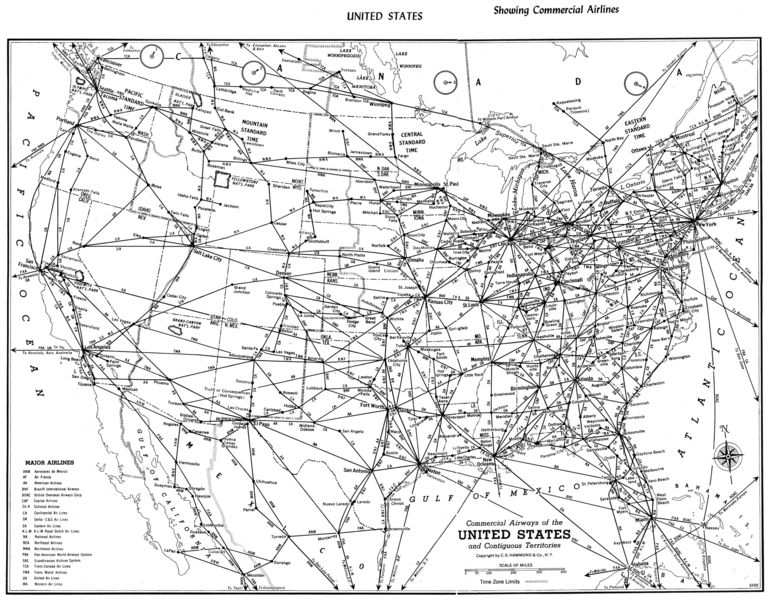
What's with all the lines? If you were planning on traveling by air in 1955, this is how you'd get there. Oh, the interstate system was still a year from even being thought of, so a trip from Fargo to Billings was better taken by air. Bus lines did exist, but, well, the busses of the time weren't much better than the yellow box kids ride to school in. That left rail, while more luxurious, was less flexible in destination. So, if you had the scratch, you could fly from Fargo to Jamestown on Northwest Airlines, something that takes a little over an hour at freeway speeds today, over long, straight Eisenhower-endorsed concrete.
see also: Stewardess uniforms * Pacific Northwest Airlines * planes of the 50s * Fargo's Hector Airport
Party at the Pfister, 1960
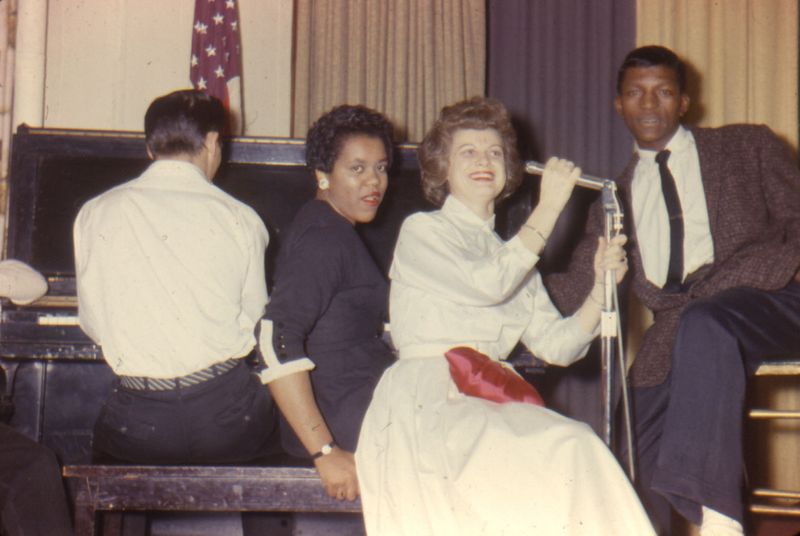 The Pfister Hotel was a happening place in 1960; at least for the employees. The wifey bought a set of slides taken by employees of the Pfister barber shop at social gatherings held in the hotel through the late 1950s and 1960. I've scanned all of the Pfister-related photos -- they're collected here.
The Pfister Hotel was a happening place in 1960; at least for the employees. The wifey bought a set of slides taken by employees of the Pfister barber shop at social gatherings held in the hotel through the late 1950s and 1960. I've scanned all of the Pfister-related photos -- they're collected here.see also: The Pfister Hotel (also) * Desegregation in Wisconsin * WI hotels via Lileks
Labels: 1950s, 1960s, hotels, milwaukee, pfister hotel, wisconsin history











